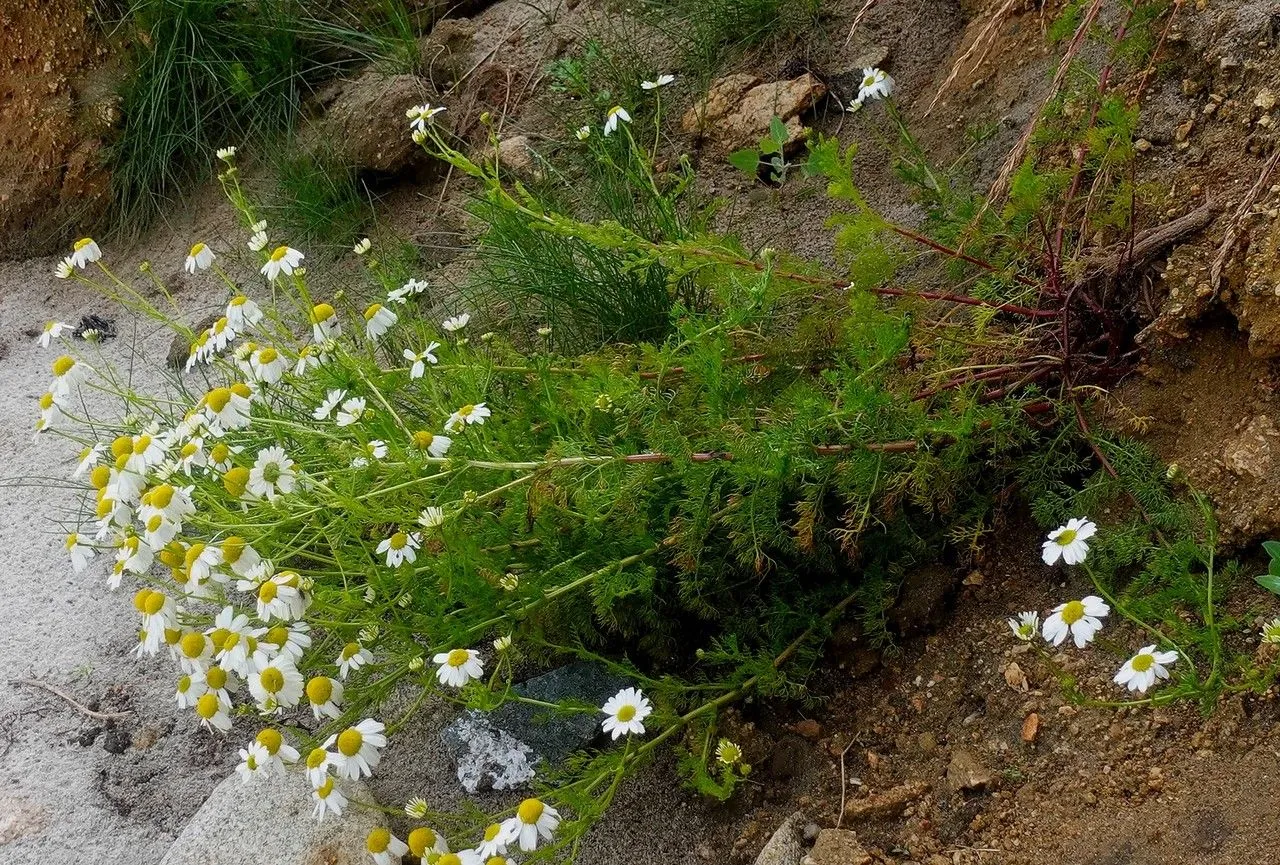
Author: (L.) W.D.J.Koch
Bibliography: 1026 (1845)
Year: 1845
Status: accepted
Rank: species
Genus: Tripleurospermum
Vegetable: False
Observations: Greenland, Azores (Pico), Europe
The Coastal scentless mayweed, scientifically known as Tripleurospermum maritimum, is a resilient and widespread plant species notable for its presence in varied and often harsh environments. Esteemed botanist W.D.J. Koch classified this species in 1845, contributing significantly to our understanding of this robust member of the Asteraceae family.
A distinctive trait of the Coastal scentless mayweed is its ability to thrive in coastal areas where salinity and wind conditions would challenge less hardy plants. This adaptability is key to its survival and widespread distribution in regions such as Greenland, the Azores, specifically on Pico Island, and across various parts of Europe.
Characteristically, the plant exhibits the typical daisy-like flowers associated with many members of the Asteraceae family, albeit with a unique absence of the strong scent common to many of its relatives. This absence of scent is what primarily distinguishes the Tripleurospermum maritimum from other similar species, thereby lending it the common name “scentless.”
These plants often flourish in environments where they can capture ample sunlight and exhibit a growth habit that often sees them forming dense, ground-covering mats. Their leaves are finely divided, contributing to the plant’s delicate appearance despite its tough nature.
Ecologically, the Coastal scentless mayweed plays a role in stabilizing sandy soils and providing habitat and food for various invertebrate species. Its flowers attract a range of pollinators, including bees and butterflies, helping maintain local biodiversity.
In summary, the Coastal scentless mayweed, or Tripleurospermum maritimum, is a modest yet ecologically significant plant that underscores the resilience and adaptability of nature. Its widespread presence in diverse and challenging environments highlights both its evolutionary success and its importance to the ecosystems it inhabits.
Deu: geruchlose kamille, küsten-kamille
Dan: strand-kamille
Eng: coastal scentless mayweed, false mayweed, scentless mayweed, sea mayweed, seaside chamomile, false chamomile
Swe: kustbaldersbrå, bårdbaldersbrå
Fra: matricaire inodore, matricaire maritime
Nld: reukeloze kamille, reukloze kamille
Sme: gáddejámešbatni, riddojámešbátni, riddočehpor
Cym: amranwen arfor, ffenigl arfor
En: Coastal scentless mayweed, False mayweed, Scentless mayweed, Sea mayweed, Seaside chamomile, False chamomile
Ca: Camamilla inodora
Da: Strand-kamille
Nl: Reukeloze kamille, Reukloze kamille, Zeekamille
Fr: Matricaire inodore, Matricaire maritime
De: Geruchlose Kamille, Küsten-Kamille, Strandkamille
Se: Gáddejámešbatni, Riddojámešbátni, Riddočehpor
Sv: Kustbaldersbrå, Bårdbaldersbrå
Cy: Amranwen Arfor, Ffenigl Arfor
Taken Mar 20, 2013 by Tela Botanica − Liliane Roubaudi (cc-by-sa)
Taken Aug 6, 2019 by Manolita Filippi (cc-by-sa)
Taken Mar 14, 2022 by Pierre LEON (cc-by-sa)
Taken Jul 12, 2021 by Pierre LEON (cc-by-sa)
Taken Sep 4, 2018 by Gaifém Luís (cc-by-sa)
Taken Jul 13, 2021 by Güenas Yerbas (cc-by-sa)
Taken Mar 14, 2022 by Pierre LEON (cc-by-sa)
Taken Dec 31, 2020 by sylvain Blondel (cc-by-sa)
Taken Jul 12, 2021 by Pierre LEON (cc-by-sa)
Taken Jul 12, 2021 by Pierre LEON (cc-by-sa)
Taken Apr 10, 2022 by monique corlay (cc-by-sa)
Taken Jul 13, 2021 by Güenas Yerbas (cc-by-sa)
Taken Jun 9, 2021 by Uxeli (cc-by-sa)
Taken Mar 14, 2022 by Pierre LEON (cc-by-sa)
Taken Jul 12, 2021 by Pierre LEON (cc-by-sa)
Taken Jul 19, 2019 by roo roo (cc-by-sa)
Taken Aug 15, 2020 by grutz (cc-by-sa)
Taken Mar 14, 2022 by Pierre LEON (cc-by-sa)
Taken Aug 14, 2021 by Pierre LEON (cc-by-sa)
Taken Sep 15, 2005 by Photoflora – Benoit BOCK (©)
Taken Sep 15, 2011 by Photoflora – Benoit BOCK (©)
Taken May 7, 2018 by Rossella Giua (cc-by-sa)
Taken Mar 20, 2013 by Tela Botanica − Liliane Roubaudi (cc-by-sa)
Taken Mar 20, 2013 by Tela Botanica − Liliane Roubaudi (cc-by-sa)
Taken Mar 20, 2013 by Tela Botanica − Liliane Roubaudi (cc-by-sa)
© copyright of the Board of Trustees of the Royal Botanic Gardens, Kew.
© copyright of the Board of Trustees of the Royal Botanic Gardens, Kew.
© copyright of the Board of Trustees of the Royal Botanic Gardens, Kew.
Growth habit: Forb/herb
Ph maximum: 8.0
Ph minimum: 7.5
Light: 9
Atmospheric humidity: 6
Soil nutriments: 8
Soil salinity: 6
Family: Myrtaceae Author: (F.Muell.) K.D.Hill & L.A.S.Johnson Bibliography: Telopea 6: 402 (1995) Year: 1995 Status:…
Family: Rubiaceae Author: Pierre ex A.Froehner Bibliography: Notizbl. Bot. Gart. Berlin-Dahlem 1: 237 (1897) Year:…
Family: Sapindaceae Author: Koidz. Bibliography: J. Coll. Sci. Imp. Univ. Tokyo 32(1): 38 (1911) Year:…
Family: Asteraceae Author: A.Gray Bibliography: Pacif. Railr. Rep.: 107 (1857) Year: 1857 Status: accepted Rank:…
Family: Fabaceae Author: Medik. Bibliography: Vorles. Churpfälz. Phys.-Ökon. Ges. 2: 398 (1787) Year: 1787 Status:…
Family: Aspleniaceae Author: (Cav.) Alston Bibliography: Bull. Misc. Inform. Kew 1932: 309 (1932) Year: 1932…